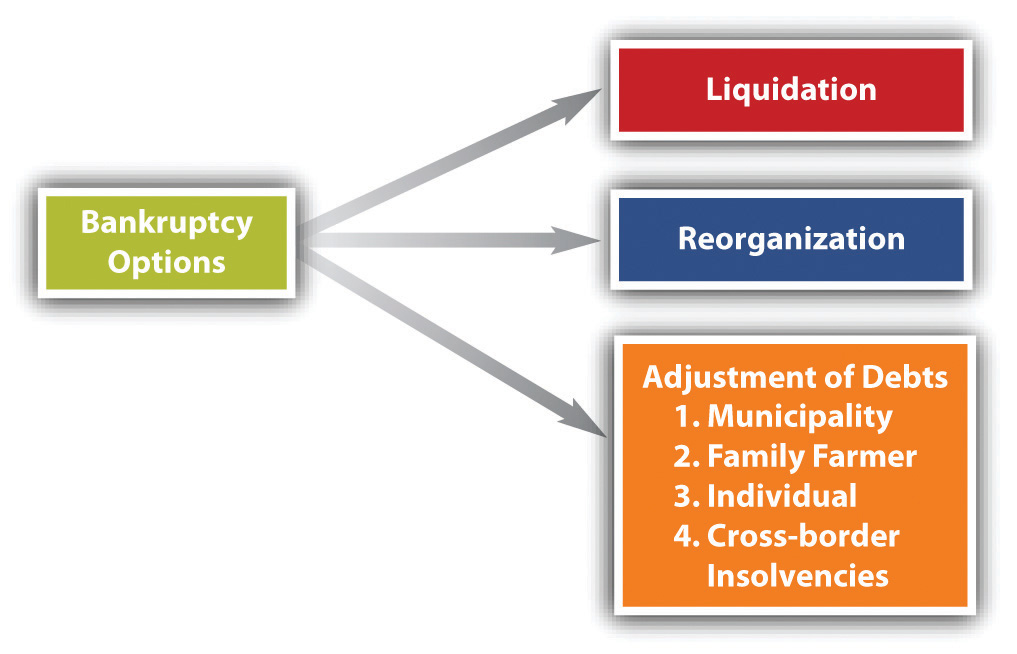
Image source: https://saylordotorg.github.io/text_foundations-of-business-law-and-the-legal-environment/section_16/d688d9ca8d4571331968f8f4fd757539.jpg
Chapter 7 is the form of bankruptcy that is the most sought after as it is the "clean-slate" option to bankruptcy. It is important to recognize that calling it a "clean slate" is far from accurate and that the most accurate part is not only the hopeful elimination of debts but the liquidation and elimination of personal property and assets, including those which have been "hidden." It is also very difficult to qualify for. This causes people to be forced into Chapter 13. Even if you qualify, Chapter 7 may not be the best answer for you if you want to decide your fate and protect yourself and your assets while avoiding a 10 year bankruptcy filing on your credit.
Here is a breif look at how to file Chapter 7 Bankruptcy. Chapter 7 bankruptcy starts when a debtor (person in financial distress) files a petition. Debtors then have to satisfy a means test (an income limit) and attend an approved credit counceling program before the chapter 7 filing will be accepted. Debtors also must file a "schedule" under oath which explains in detail the financial information of the debtor. A schedule lists out the value of the property, income, debts, creditors, or any debt or obligation they wish to discharge in bankruptcy.
Upon approval, the case is assigned a "trustee" whose job it is to liquidate or sell the "nonessential" assets of the debtor. What may be considered "essential"? Usually one home and one car. These must NOT be excessive or they may be sold off for more modest assets. The trustee reviews the schedules provided and conducts an investigation called "the meeting of creditors." The court notifies all creditors involved in this meeting. Each Creditor will have the option to contest the filing and whether the debt is dischargeable. This will extend the proceeding 3 to 6 months and, if the creditor wins, potentially dismiss the filing altogether. The creditors will continue to try to collect until the court orders an automatic stay, which is a "stop sign" for creditors to cease collection efforts. The trustee determines that nonessential assets can be sold for the benefit of the creditors, i.e. investment properties, 2nd homes (regardless of who lives there, including your grandma), additional vehicles, recreational assets, excess equity in essential assets, etc.
Any secured debts (mortgages, liens, etc.) will STILL retain their first positions and repossess these related assets. Bankruptcy usually does nothing to protect these assets. It is important to understand that Bankruptcy deals primarily with unsecured creditors and, in many cases, may allow them to become secured as liens on available assets.
If, during the course of the "meeting of creditors", it is determined you have too few assets, the trustee will pursue a more thorough investigation in search of assets that have not been admitted with the schedule forms which were delivered under oath as being 100% accurate. The Federal Rule of Bankruptcy Procedure 2004 conveys broad powers of investigation on trustees and creditors to question parties under oath among other demands for documents and information. The trustee WILL perform an investigation if they, or a creditor, deems it prudent. This is to allows creditors maximum recuperation through access to assets that may have been hidden by the debtor. They may use this to find assets that may have been sold or given away that should have been available to creditors. 11 U.S.C. s 547 & 548 allows the trustee to sue individuals who received preferential treatment - that is the transfer or payment of $600 or more in assets or property to an "insider" (defined as a relative, friend, partner, etc.) within the last year. The trustee may sue in order to recover this property as it is considered an attempt to defraud creditors. This includes property or assets sold, transferred, given, and hidden from creditors and/or the court. In essence, NO ASSETS ARE PROTECTED.
This is only a brief explanation of possibilities and process for Chapter 7 bankruptcy. An endless number of issues may require the debtor to appear in court for defense and continuation of the filing in order to complete the bankruptcy proceeding. The creditors may contest, judges may require explanation, debtors may fail to comply with conditions of bankruptcy, and ultimately you may not qualify for Chapter 7!
As of October 2005, you are LUCKY if you qualify for chapter 7 bankruptcy! The statutes and requirements were tightened considerably, causing the vast majority of those seeking chapter 7 protection to look at other alternatives. If your evaluating bankruptcy be very careful or you may be forced into a government mandated 3-5 year payback plan under chapter 13 bankruptcy.
Ultimately, Chapter 7 leaves you with nothing more than a roof over your head and transportation, a bankruptcy on your credit file, and continued issues with secured creditors as they pursue foreclosure and repossessions that the bankruptcy did not cover.